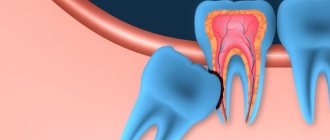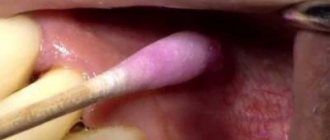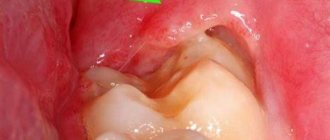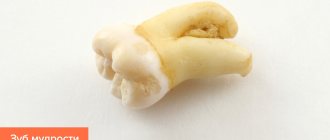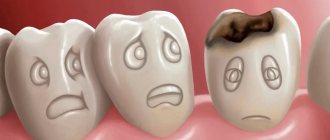In this article
- What is a wisdom tooth and where is it located?
- Why does figure eight caries occur?
- A wisdom tooth affected by caries - treat or remove?
- Pros and cons of treatment tactics for wisdom teeth for caries
- In what cases does wisdom tooth treatment make no sense and must be removed?
- Pros and cons of removal tactics for caries of the lower or upper eights
- Step-by-step treatment of wisdom tooth caries
- How is a wisdom tooth removed?
- Is it necessary to place an implant instead of a removed figure eight?
When caries is detected, there is usually no question of what to do. He is treated immediately. But if caries is found on a wisdom tooth, a person may be faced with a choice - to treat or remove it. We will tell you in this article how to deal with caries of eights correctly.
What is a wisdom tooth and where is it located?
The name “wisdom tooth” is assigned to the third molar, the so-called figure eight, the eighth tooth in a row. The period of wisdom teeth eruption is approximately from 20 to 27 years. In rare cases, they appear after 40 years. It is precisely with the age of eruption that the name of eights—“wisdom teeth”—is associated, because in fact they appear in a person during the period of maximum maturity of the body.
It is interesting that in some people, despite the presence of the rudiments of teeth, they may not erupt throughout their lives. Scientists explain this fact by the fact that in the process of evolution, modern people's jaw has become shorter by about 12 mm compared to their ancestors, which is due to softer food, when chewing which there is no heavy load on the jaw.
If figure eights do erupt, they often cause pain and discomfort to the person. If the jaw is small, then in the process of growth the eights can shift the dentition, which leads to the curvature of other teeth. Therefore, many people try to remove them whenever possible. But the very fact of having a “wise” tooth is not always a reason for its removal.
international experience
In different countries, the answer to the question: “Do you always need to remove wisdom teeth?” different. In the USA, 8s are removed already in adolescence, before they lead to problems, that is, they act according to a preventive scenario. In the CIS countries, if teeth erupt correctly and do not cause problems, they are left behind. Apparently this is due to the characteristics of healthcare models.
At the same time, many scientific works on this problem among conscript soldiers in the Russian Federation attract attention, and it is no coincidence. It is at this moment that wisdom teeth begin to actively grow and reveal previously hidden problems. And treatment often requires surgery.
Why does figure eight caries occur?
According to statistics, caries of problem eights is much more common than caries of other teeth. At the same time, the main reasons for the development of carious lesions are not much different from those with damage to any other part of the jaw. These include:
- Hereditary factors.
- Poor hygiene.
- Excess sugars and fast carbohydrates in daily nutrition.
- A specific risk factor is the location of the third molar. Typically, the wisdom tooth erupts at an angle, which makes it difficult to properly clean it during daily hygiene procedures. In hard-to-reach areas, food debris accumulates, which serves as a breeding ground for bacteria. By fermenting carbohydrates, bacteria produce organic acid, which leads to caries of the upper or lower 8 teeth.
A wisdom tooth affected by caries - treat or remove?
According to statistics, when affected by caries, in approximately 20% of cases, the wisdom tooth can be treated, in 80% it can be removed immediately. The question of treating or removing figure eights is decided by the dentist, taking into account the individual characteristics of a particular patient.
In what cases can experienced dentists treat caries of third molars:
- If the tooth is in satisfactory condition, the carious lesion is superficial or in the stain stage and there are no obstacles to successful treatment.
- It is very desirable to treat wisdom tooth caries if for some reason the patient has had his sixth or seventh teeth removed and the eights bear a large chewing load.
- Treatment of a wisdom tooth affected by caries is also necessary if the figure eights act as a support for orthopedic structures - bridges, crowns.
- Treatment is acceptable if there is no gingival “hood” hanging over the dental crown.
- It is advisable to preserve the tooth even if the opposite jaw also has a figure eight.
In what cases does wisdom tooth treatment make no sense and must be removed?
- If the dentist has diagnosed “deep caries of the wisdom tooth,” it makes no sense to treat the disease at this stage. In this case, the tooth is simply removed.
- Figure eights affected by caries are removed if they are incorrectly located in the row of the masticatory-maxillary system.
- Extraction (removal) is carried out for chronic recurrent pericoronitis - if the patient regularly has inflamed gums around the eighth tooth.
- The figure eight should be removed if it injures the soft tissues of the inside of the cheeks. This happens when wisdom teeth are incorrectly positioned.
- Treatment of eighth teeth is not carried out if the patient cannot fully open his mouth or there are other obstacles to the procedure.
- Caries will not be treated if the third molars violate the position of the dentition and cause crowding of the canines and incisors. In such situations, the doctor often removes the figure eights and then performs orthodontic correction of the displaced teeth.
- Basal caries and cervical caries of wisdom teeth are also indications for removal in most cases.
Need for removal
With the appearance of “wise teeth,” every person experiences some discomfort, since in most cases this process is quite painful and unpleasant. In some cases, unbearable pain appears even when such a tooth has not yet erupted, but is already making itself felt. What to do in such a situation?
Indeed, a huge part of the population of our planet suffered more from the appearance of wisdom teeth than they enjoyed it. Dentists often recommend removing wisdom teeth that have not yet erupted in order to rid your body of some problems.
There are many cases where a wisdom tooth brought its owner a lot of trouble due to the fact that it was impacted. In other words, an impacted wisdom tooth is a tooth that cannot break through the gums due to the presence of bone or soft tissue. Such teeth appear in people suffering from severe crowding of the dentition.
The eruption of wisdom teeth occurs from adulthood until a person reaches twenty-five years of age.
By this time, the jaw system is fully formed, where there is often not enough space for wisdom teeth.
However, even if there is no place for a wisdom tooth, he will still try to find it in the dentition.
In this case, displacement of this tooth can often be observed, both in the lower region of the jaw and to the side. This tooth may touch the root systems of neighboring teeth, as a result, the growth of the wisdom tooth is accompanied by pain. In such cases, the removal of an unerupted wisdom tooth (reviews of those who got rid of suffering once again confirm this) is simply necessary.
This impacted tooth needs to be removed in the unerupted phase, since there is a high probability of curvature.
To accurately remove an unerupted wisdom tooth, an x-ray is first taken, which clearly shows its location relative to other teeth. This will allow removal to be carried out carefully and safely.
To prevent the appearance of an impacted tooth, it is necessary to visit the dental office at least once every six months for early diagnosis.
Pros and cons of removal tactics for caries of the lower or upper eights
Advantages of the extraction (removal) method:
- it is possible to completely eliminate the infectious focus, prevent the spread of the inflammatory process to adjacent teeth and nearby tissues;
- eliminates the risk of crowded teeth and the need for orthodontic correction;
- the risk of recurrent caries is eliminated;
- removal of the third molar allows you to radically solve the issue of pain in the area of this tooth.
The negative aspects of removing wisdom teeth include the risk of postoperative complications, as well as the inability to install a support for bridges or crowns on the figure eights, if necessary.
Why are sutures required after wisdom tooth removal?
Extraction of the third molar requires suturing. It is not always possible to save the patient from the procedure described above. Even when working with high-quality equipment, a competent dentist will encounter problems. The third molar is secured with the help of two roots, the removal of which requires making a few incisions, and then removing the tooth body from the gum. Sutures are also applied if there are clinical signs of gum inflammation. Swelling is considered a natural process for the body, due to damage to the gums during incisions. The suturing procedure is also a preventive measure, which reduces the risk of infectious pathological syndrome; pathogenic bacteria do not penetrate into the open wound. The smaller the size of the wound, the lower the likelihood of infection, the age the rate of regeneration. Regardless of the type of thread used, suturing takes a short period of time. Self-absorbable threads are a more preferable option; they do not need to be removed and re-injure the gums.
Step-by-step treatment of wisdom tooth caries
If the dentist gave a positive answer to the question of whether to treat wisdom teeth, it is necessary to begin treatment as early as possible, before caries reaches a more advanced stage. The treatment procedure for third molars is slightly different from the treatment of other teeth in the upper or lower jaw, since due to the special arrangement of the teeth, the doctor cannot use all available technologies.
Treatment occurs in several stages:
- After anesthesia, the dentist carefully prepares the cavity and, using a drill and hand instruments, removes all tissue affected by caries.
- To prevent infection from entering the body, he treats the oral cavity and the tooth itself with an antiseptic solution.
- The dentist places a healing or insulating pad inside the cleaned cavity.
- A seal made of photocomposite material is installed on top of the gasket. It is applied in layers, and each layer is illuminated with a special lamp until completely cured.
- After filling, the tooth is adjusted to the bite, given the correct anatomical shape, ground and polished.
How is a wisdom tooth removed?
Depending on a number of factors, the removal procedure can be simple or complex. If there are a small number of roots or their weak connection with the jaw, removing a tooth will not be difficult; the entire procedure will take about 20 minutes.
If the tooth is in the wrong position, has not grown completely, is located under the gum, has fused with the jaw, the roots are intertwined with the roots of other teeth, or a cyst has formed, in such situations the removal procedure will be difficult and will take at least an hour.
Any removal of third molars is a dental procedure performed under local anesthesia. It should be performed by an experienced dental surgeon, so contact only reliable clinics.
The removal procedure occurs in several stages:
- First, an x-ray is taken so that the doctor can understand the exact location of the tooth.
- The specialist selects anesthesia taking into account individual tolerance and gives an anesthetic injection.
- After a few minutes, when the anesthesia takes effect, the removal begins directly. Depending on the complexity, the procedure will take from 20 to 60 minutes.
- The doctor carefully makes incisions, removes the affected wisdom tooth, then treats the jaw with antiseptics and, if necessary, applies stitches.
- After the procedure, the dentist gives recommendations on how to care for your mouth and teeth after surgery. Typically, you should not eat for a couple of hours after the procedure, and you should not rinse your mouth forcefully for a while.
- If inflammation is present, the patient is prescribed antibacterial drugs. They will stop the inflammatory process and prevent the risk of infection spreading to other tissues.
When to remove gum sutures
Even if the wound was sutured with a self-absorbing thread, it is worth checking with your doctor whether it needs to be removed and when. The surgeon must ensure that the operation performed does not cause late complications. Therefore, you need a second visit to him after 7-10 days to determine how many days later to remove the sutures from the gums.
If there is no swelling, redness, or pain, the doctor will remove the stitches. If tissue healing is incomplete, you may need another visit in 2-3 days, during which the material used to close the wound will be removed.
Does it hurt to take it off?
When the suture thread is removed, the patient feels discomfort. Pain when pulling out suture material is rare, due to individual sensitivity or in the presence of a complication in the form of inflammation. If the patient's pain threshold is reduced, superficial anesthesia with Novocaine or Lidocaine spray is used.
How to remove sutures on the gums
Before removing stitches:
- The surgeon will treat the oral cavity with an antiseptic.
- Examine the mucous membrane of the oral cavity: it is necessary that there is no pain, fever, redness, swelling, and no fluid or pus is released from the wound area.
- The thread is cut with a special dental instrument. When the seam is continuous, the cut will be in several places; if it is intermittent, then all the stitches will be cut in half.
- Using fingers or tweezers, the surgeon will pull out pieces of thread and check how well the scar is formed on the wound.
After removing the stitches, the patient will rinse their mouth with an antiseptic.
For 1–3 days, unpleasant sensations in the jaw and gums are possible when moving.
The wound after tooth extraction heals completely within 2–3 weeks. In young people this process is faster. The sockets of single-rooted teeth can heal completely on the 14th day, multi-rooted ones - by the 20th day after surgery.
In case of purulent complications, healing will be delayed for a week for a single-rooted tooth, and 2 for a multi-rooted one.
The more traumatic the operation was, the larger the volume of tissue that was subjected to intervention, the longer the healing.
The surgeon still removes the absorbable sutures so that they, being on the gums for a long time, do not provoke inflammation.
Removing the suture material too early may prevent a clot from fully forming in the wound. In this case, inflammation is also possible.
Sometimes patients get in the way of the threads, and the question arises of how to remove the sutures from the gums on their own, at home, if there is no pain or swelling. What to do if the surgeon is far away, and it’s impossible to tolerate when the threads become hard and rub against the tongue or gums, causing irritation of the mucous membrane?
In principle, the stitches can be removed by the patient himself. But this is fraught with infection in the wound.
At home, you must follow all the rules of asepsis and antisepsis; you cannot keep your instruments sterile. Safe removal of the threads used to suture the gum wound is only possible by a dentist.
Is it necessary to place an implant instead of a removed figure eight?
Theoretically, a dental implant can be placed in place of an extracted wisdom tooth that has been affected by caries. But in practice this is not done for a number of reasons. Firstly, the anatomical location of the tooth makes such implantation extremely difficult. Secondly, the load on the eighth tooth will sooner or later lead to loosening of the rod on which the implant is attached. Food will get into the gaps formed and microbes will multiply, which can lead to inflammation. Thirdly, even with proper installation of the implant, there will still be a joint between the gum and the crown, in which bacteria will accumulate if hygiene is difficult.
And finally, replacing a removed figure eight with an implant does not make practical sense, especially if a person’s other chewing teeth function normally. Also, the absence of these teeth does not impair the quality of life and does not affect human health. Therefore, after removing the third molar, there is no need to install an implant in its place.
How to understand that complications have arisen after suturing?
Alarming symptoms after removing the “eight” are as follows:
- heavy bleeding that lasts more than a day;
- severe pain, throbbing pain that prevents you from sleeping or leading a normal life;
- very large swelling;
- redness in the intervention area;
- blood in saliva in the first three days after the intervention;
- elevated body temperature.
In all these cases, you must consult your doctor. It is possible that stitches will have to be stitched again to avoid complications.
